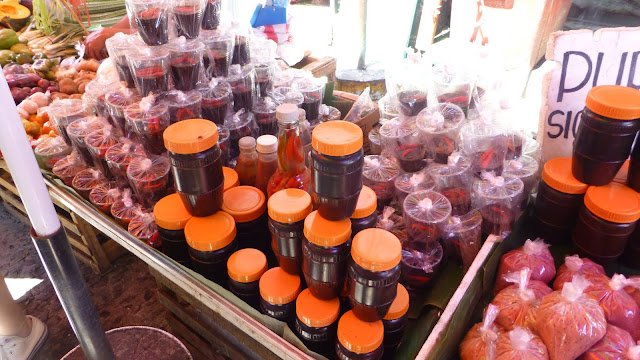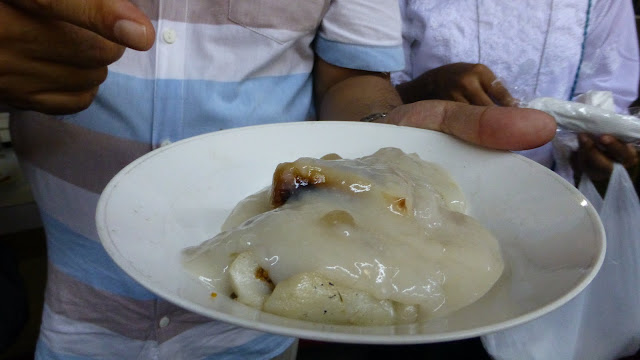Hola! Que tal man usted?
It certainly made me wish I had paid more attention during all those spanish classes in high school and college.
Our air conditioned jeepney arrived at the Cavite City Public Market in Barangay San Roque at a time when most of the early regular shoppers had come and gone. But since it was a Saturday and "market" day, the place was still bustling with activity.
Nothing like a visit to the public market to get a feel and sense of a town and its people.
The orderly and neat palengke certainly speaks well about the people of Cavite City.
Our tour guide, Cavite son Ige Ramos walked us through the stalls where the local specialties were sold. This is his suki for tinapang salinas, a smoked dried fish that Cavite is famous for.
This little table stocked with homemade bagoong (shrimp paste) and patis (fish sauce) looked
so tempting!
I really wanted to buy some of the local patis. Cavite's patis is darker and more intense with
a deep, umami rich flavour. However, the fear of causing a pungent stink in the coaster kept
me from taking a few bottles home.
The province of Cavite is a peninsula, jutting out into Manila Bay. Its location makes it a prime source for fresh fish and seafood. I hadn't seen torsillo in such a long time! This barracuda like fish was a favourite of my father's, for making paksiw.
Another paksiw favourite that my father liked was chabeta. It was nice to get re-acquainted here,
in the Cavite City palengke. If I had explored some more, I am sure I would have found more familiar favourites.
Kalamay has the power to make me stop dead in my tracks. This is a bilao of a Caviteño delicacy --
a latik-topped rice cake that is eaten with a ginataan sauce.
We passed by a stall that makes lumpia wrappers -- see the hot griddles where the batter is spooned out. See also the lumpia wrapper maker napping on one side -- taking a break from the rigours of lumpia wrapper making.
The lumpia wrappers are packed and waiting for buyers. When I was young, they were stacked
in 10s or 20s with banana leaves in between. Now they're wrapped in more sanitary air tight plastic bags. I much prefer the old fashioned and environmentally correct packaging.
The dry goods section has all sorts of indispensable household stuff -- including these Hello Kitty and robot drummers.
Ige finally manages to shepherd us all to our eating stop -- Aling Ika's carinderia. I suppose every full blooded resident of Cavite City has at one point in his life eaten and enjoyed Aling Ika's food. Ige also said that balikbayans make a beeline for this place, to recapture the much craved for
tastes of home.
The carinderia dates back to pre-war days so Aling Ika has long since retired to that huge airy
kitchen in the sky. Her surviving family members run the carinderia, keeping her memory and
her best loved recipes alive.
Since it's past peak dining hours for the carinderia when we arrive, the ulam (viands) in the eskaparate (glass showcase) are nearly depleted. But no matter, Ige reassured us that he has "reserved" the best for us to taste.
What we normally call ukoy or shrimp fritters, the Caviteños call "basag ulo" or literally, "smash heads". "Basag ulo" which is slang for a fight or scuffle refers to the heads of the shrimp,
pounded or "smashed" for flavour before being fried in a batter along with the chopped vegetables.
Dip the "basag ulo" in a spicy toyo and suka sauce and experience a pounding of your tastebuds.
Thank goodness Ige had them put some pancit puso aside for us to try. This uniquely Caviteño noodle dish uses bihon (rice noodles), miki (egg noodles) and strands of puso ng saging
(heart of banana).
I think the thinly sliced puso ng saging is first made into a kilawin (cooked in vinegar) before
it is sautéed with the noodles -- thus giving the pancit a deliciously light tart taste.
Aling Ika's version comes with chicharon (pork crackling) pieces which add a salty crunch, tying
all the flavours together.
I very much enjoyed my mouthful of pancit puso and strangely enough, it reminded me of a
mild version of my all-time pancit favourite ... pancit malabon. It must be the "maasim-asim, maalat-alat" flavour profile.
Caviteños love their chicharon. The fresh vegetable lumpia or lumpia fresca as they call it in chavacano is generously topped with more chicharon bits -- a welcome variation from the chopped peanuts that I am normally used to. The lumpia is so good, there is no need for any sauce.
Aling Ika's tortang alimasag (crab omelet) is one of her best sellers. It's such a crowd favourite that the carinderia runs out of it very early in the day. Thankfully, one large slice had been set aside for us so we each had a small bite.
The tortang alimasag was excellent! The crab was sweetish and fresh and tasted like it had just
been caught that morning -- as it probably had been.
No extenders or fillers in this torta -- just a generous amount of fresh alimasag sautéed with
onions and tomatoes, with a bit of red pimiento perhaps? A bit of paprika maybe? I guess I'll just have to eat more to find out!
For dessert, we just had to try Aling Ika's version of the popular bibingkoy. It starts off as plain
mochi -- glutinous rice cake squares with a browned almost blackened top crust and filled with
soft sweet red beans. We have the same rice cake in Bataan, where I come from. I have always liked the gooey-gummy mouthfeel of mochi.
But wait, don't eat that bibingkoy just yet! Wait for the coup de grace -- a topping of creamy,
rich ginataan (coconut cream dessert) mildly flavoured with langka (jackfruit) and studded
with bilo bilo (glutinous rice balls). I felt like I was eating two things at the same time, the chewy, bean filled mochi and the classic ginataan. Dessert overload at Aling Ika's carinderia!
It's business as usual despite all of us crowding around and trying to take photos of the carinderia and the food. Ige said that food runs out as the market closes towards noon so if you want to eat at Aling Ika's and order the specials, it's best to get there bright and early!
I leave Aling Ika's and the market with smiling tastebuds. It's unheard of that I go to the palengke and leave without buying anything. But we still had a few more stops to go on our Culinary and History tour and the things I wanted to buy were either perishable (the fish) or potentially "offensive" (the patis). It does give me the perfect excuse to plan a trip back to the Mercado del Ciudad de Cavite soon!
Gracias, anda ya yo!













































